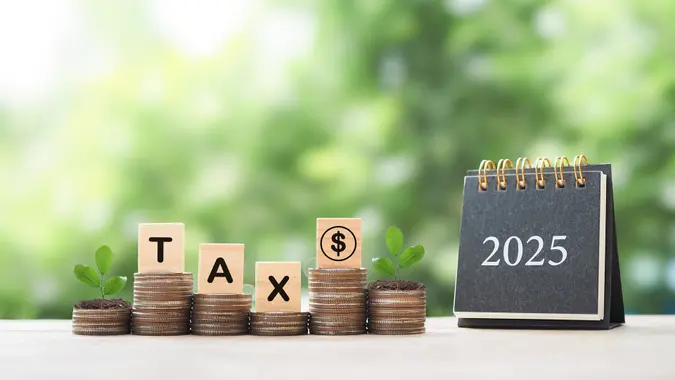Tax Day Countdown: 8 Tax Rebates You Probably Qualify for in 2025

Commitment to Our Readers
GOBankingRates' editorial team is committed to bringing you unbiased reviews and information. We use data-driven methodologies to evaluate financial products and services - our reviews and ratings are not influenced by advertisers. You can read more about our editorial guidelines and our products and services review methodology.

20 Years
Helping You Live Richer

Reviewed
by Experts

Trusted by
Millions of Readers
Once your taxes are filed, you tend to stop caring about every little detail as long as you have it done. However, before you check all your itemized deductions and calculate your individual income tax to get the fattest tax refund possible, there may be a few other things you should research this tax season.
Tax rebates provide a quick reimbursement from the IRS, based on money you spend on qualifying purchases. There aren’t currently any federal tax rebates on offer, but many tax credits work nearly identically — you just have to wait a little longer for Uncle Sam to pay you back, but you will receive a refund when you file your taxes with these in mind.
Some tax credits even qualify as “refundable,” meaning the IRS pays you for them even if you don’t owe any taxes at all for your 2024 tax year. This filing season may be coming to a close, but before you rush your filing status, it’s good to know which rebate (in the form of a tax credit) you qualify for so you can take that cash and put it toward everything from funding emergency savings to padding your retirement plans.
If you’re overwhelmed by the impending tax deadline, you can try for an extension, opt to speak with a professional or even use a full-service filing tax software to help you avoid any tax liabilities. However, if you are ready to file, before you hit send, consider whether any of the following tax credits make sense for your budget in 2025 and beyond.
Earned Income Tax Credit
Low- to moderate-income earners can score cash back from Uncle Sam through the Earned Income Tax Credit (EITC).
The exact amount in 2025 depends on how many children you have:
- No qualifying children: $649
- 1 qualifying child: $4,328
- 2 qualifying children: $7,152
- 3 or more qualifying children: $8,046
The IRS sets income limits based on the number of children and whether you file as single or married. Through the EITC, some families not only avoid paying taxes, but the IRS returns money to them. Now that feels like a substantial tax deduction.
Child Tax Credit
More families qualify for the child tax credit, with its higher household income limit of $200,000 ($400,000 for married couples).
Families receive up to $2,000 per qualifying child. To qualify, you must claim the child as a dependent on your tax return, the child must be under age 17 at the end of the year, and they must have a Social Security number.
For lower-income families who don’t pay much (or any) federal income taxes, the child tax credit is partially refundable. Families can take refunds from the IRS up to $1,700 per child. In fact, some states offer their own additional child tax credits.
“For example, in New York the Empire State Child Credit allows residents with kids under 17 to receive up to $1,000 per child under four and $500 per child aged four to 16,” explained Steven Sarrel, a certified public accountant (CPA) and partner at Raines & Fischer, LLP.
Child and Dependent Care Credit
Children are expensive, to put it mildly. For that matter, aging parents and other dependents can also put a hurting on your household finances.
“If you pay for childcare or dependent care, you can claim expenses like daycare or after-school programs,” added Sarrel. “The credit also covers home health aids if you are taking care of an elderly parent or family member.”
The IRS credits 20%-35% of care expenses, up to $3,000 for one dependent and up to $6,000 for two or more.
Adoption Tax Credit
Adopting a child this year? Uncle Sam might reimburse you for some of the costs.
As Sarrel put it, “Those adopting a child in 2025 can claim up to $14,890 per child to cover fees and court costs.”
American Opportunity Credit
If you pay for higher education costs this year, you can qualify for a tax credit up to $2,500. Of that, $1,000 is refundable for lower-income Americans who don’t owe taxes.
The IRS does put an income cap on this credit, however. You can’t earn a modified adjusted gross income over $90,000 ($180,000 for married filing jointly) to qualify.
Clean Vehicle Tax Credit
The federal government offers a tax credit up to $7,500 for electric and fuel-cell vehicles. It comes with plenty of fine print, so read the full details about price limits, battery capacity and critical mineral requirements on the IRS website.
“Beyond the $7,500 in possible federal rebates, some states add their own benefits,” noted Sarrel.
“In New Jersey for instance, residents get a sales tax exemption of 6.625% when buying a new EV. In New York, you can get the ‘New York Drive Clean Rebate’ of up to $2,000 for the purchase of new electric vehicles.
“Lesser known savings are the local utility rebates from Con Edison for EV owners who install home chargers and charge their vehicles in off peak hours.”
Energy Efficient Home Improvement Tax Credit
Homeowners can score double savings by reducing both their utility and tax bills.
As Sean Lovison, certified financial planner (CFP), CPA and founder of Purpose Built Financial Services, explained, “Upgrading your home with energy-efficient windows, insulation, or solar panels can qualify you for substantial tax credits. That helps offset the installation costs to keep it affordable for middle-class homeowners.”
Check which exact home upgrades qualify at the government’s Energy Star website.
Historic Preservation Credit
Historic homes qualify for their own special home improvement tax credit.
“If you own a historic property you can get federal and state tax credits for renovations in most states,” said Sarrel.
“For example, using New York State Historic Homeownership Rehabilitation Credit you can recoup 20% of qualified rehabilitation expenditures, with a maximum credit of $50,000 per year.”
Final Take To GO
The bottom line is that all of these credits can function similarly to tax rebates, helping you recover some of the costs of upgrading your life in 2025. Do your homework on a tax credit before assuming you’ll qualify for it, and let Uncle Sam pitch in to help you go back to school, buy a new car, upgrade your home, have kids or more this year.
Caitlyn Moorhead contributed to the reporting for this article.
 Written by
Written by  Edited by
Edited by 
























